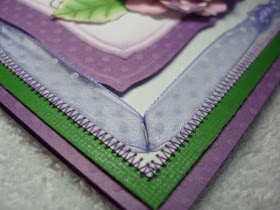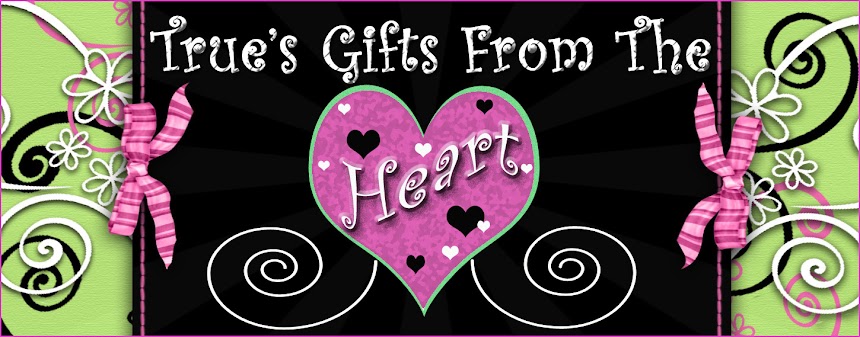Ann and Dawn from “The Next Level” asked if I would do a sewing tutorial for my first posting as a new member of their design team. Here it is…hope you like it!
Sewing on cards is not much different then sewing cloth except you need to make sure your stitching is spaced far enough apart that it doesn’t end up cutting your paper by means of perforations.
It does not matter what size needle you use. It just depends on the size of hole you want it to leave. I prefer to use a size 14 needle because I think the larger holes add an extra element to the card. I also have my bottom tension a little tighter then my top and that is because I am lazy! I hate changing the bobbin color every time I change thread colors and by having the tighter bobbin tension, which pulls the top stitch down farther, I can use white bobbin thread for all colors and it will not show in the holes. You don’t want the tensions so tight that it pulls and tears the paper at the holes or so loose that you get loops. All machines are a little different so you will want to try yours on a couple of pieces of scrap cardstock and make any adjustments if needed before sewing your card pieces. My top tension is set at 4 and my bottom at mid. You might try that as a starting point.
There are many stitches and ways to sew on cards but today I am going to share with you the way I feel is the easiest to keep a straight line. This seams to be the biggest struggle for most people when they first start sewing on paper. We will be doing a zig-zag stitch. My stitch length is set on ½ and width is 3 but you can play around and see what size you prefer. For this technique, you will not be sewing directly on the card so no stitches will show on the inside. You will need two pieces of cardstock or extra heavy weight designer paper. Thin paper does not work well for sewing. Your top piece needs to be at least ¼” smaller then your bottom paper. Once you have decided what placement you like, secure the pieces together with double sided tape or glue runner. You just need to do this in a few spots and try to place it so that it won’t be where you are stitching. Sewing through tape will gum up your needle and machine!

It is very important that you start your needle at the very tip of the corner on your top piece of cardstock, and that your needle is on the RIGHT side of the presser foot.

Start slowly at first using the edge of the top piece as your guide. Each time the needle hits the paper, on the Right side of your zig-zag, you want it to be right on the edge. Slow way down when you get to the corner. Try stopping perfectly even with the edge of the next side, with your needle again on the farthest RIGHT. If it doesn’t happen to fall that way, you can lift the presser foot and needle and reposition it exactly on the corner, then lower your foot and needle back down.

When you turn the cardstock to start your next side, leave the needle down and just lift the foot and spin the cardstock, then drop the foot back down. Continue to sew all sides in this same manor. To end, just stop even with the farthest edge of the stitching on the first side. (Do not back up the thread to secure lock like you would when sewing cloth). Lift the presser foot and carefully remove the cardstock. You might want to pull some of the thread out of the machine with your fingers while pulling the cardstock to keep from tearing.

Flip the card over and gently pull the two bobbin threads and scrape your nail against the area where they come thru the paper a few times until at least one of the top threads comes through. (If only one does that is ok. That just means the other has been stitched over and is already secure). Tape all 3 (or 4) pieces of thread to the back of your card.


If there is still a top thread on the right side of your project, just carefully trim it as close to the paper as you can.

You might want to put a very small drop of glue at the point where the thread comes through the back of the cardstock, just to double secure it. This can be done now or as you are gluing it to your card.
You are now ready to attach it to your card, ether by gluing, sticky strips or double sided dimensional tape. Note: if you will be using brads or anything that will go through this layer, do it before attaching to card so they don’t show on the inside.

If you would like, you can also finish the insides of your cards with the same process.
Well, I hope you found this tutorial helpful. If so, please leave a comment below and let me know what you think!

Great tutorial, True! I could have done with this a while ago! :)
ReplyDeleteThanks True, I've only just started sewing on my cards and found this really useful
ReplyDeleteAnne x
Thanks, great tutorial, I've never tried this before but feel inspired now to dig out my sewing machine.
ReplyDeleteJan xx
Fab tutorial True, thankyou, I have only just started using a machine and this has been very helpful thankyou, especially keeping straight hehehe.
ReplyDeleteLove n hugs
Vikki xx
True your tutorial was fabulous. I have always been curious about sewing on cards and now I have an idea of what I need to do. Get a sewing machine!!! LOL!!! I am going to put it on my wish list and maybe the hubby will get me one. { fingers crossed } Hugs XXX Beth
ReplyDeleteI've just popped over to your blog from The Next Level, just want to say thank you for the tutorial which was great and very easy to follow and the card you made is really beautiful
ReplyDeleteMarion UK
Just popped over from The Next Level to say thank you for the great tutorial which is very easy to follow and the card you made is really beautiful
ReplyDeleteMarion UK
would really love to know how you did the corners of the ribbon and also to see the whole card.
ReplyDeleteoh, now I see your whole card and I followed your link to The Next Level to see how the ribbon border was done. Should have looked ahead a bit before I left my previous comment! Beautiful card, and that ribbon border is something special.
ReplyDeleteAlright, thanks so much for sharing this expert tip on sewing! We love it when you teach us True :) Great job ~Jeni
ReplyDeleteThese are really lovely gift ideas. And your pics were really clear and helpful!
ReplyDeleteThanks for the tutorial.....I'm going to try this tomorrow!
ReplyDeleteThanks True, I usually hand stitch becasue I can never get it neat and even with my machine, but after reading your tut. I'll have to pull my machine back out!
ReplyDeletexx